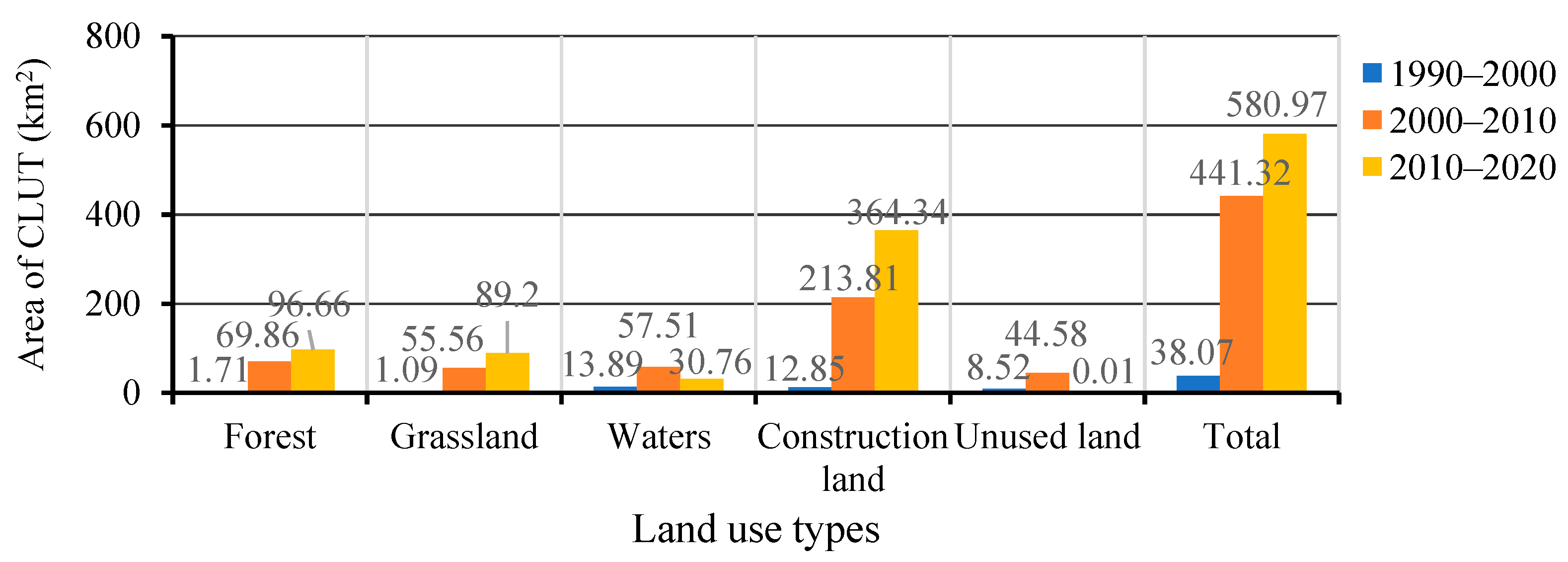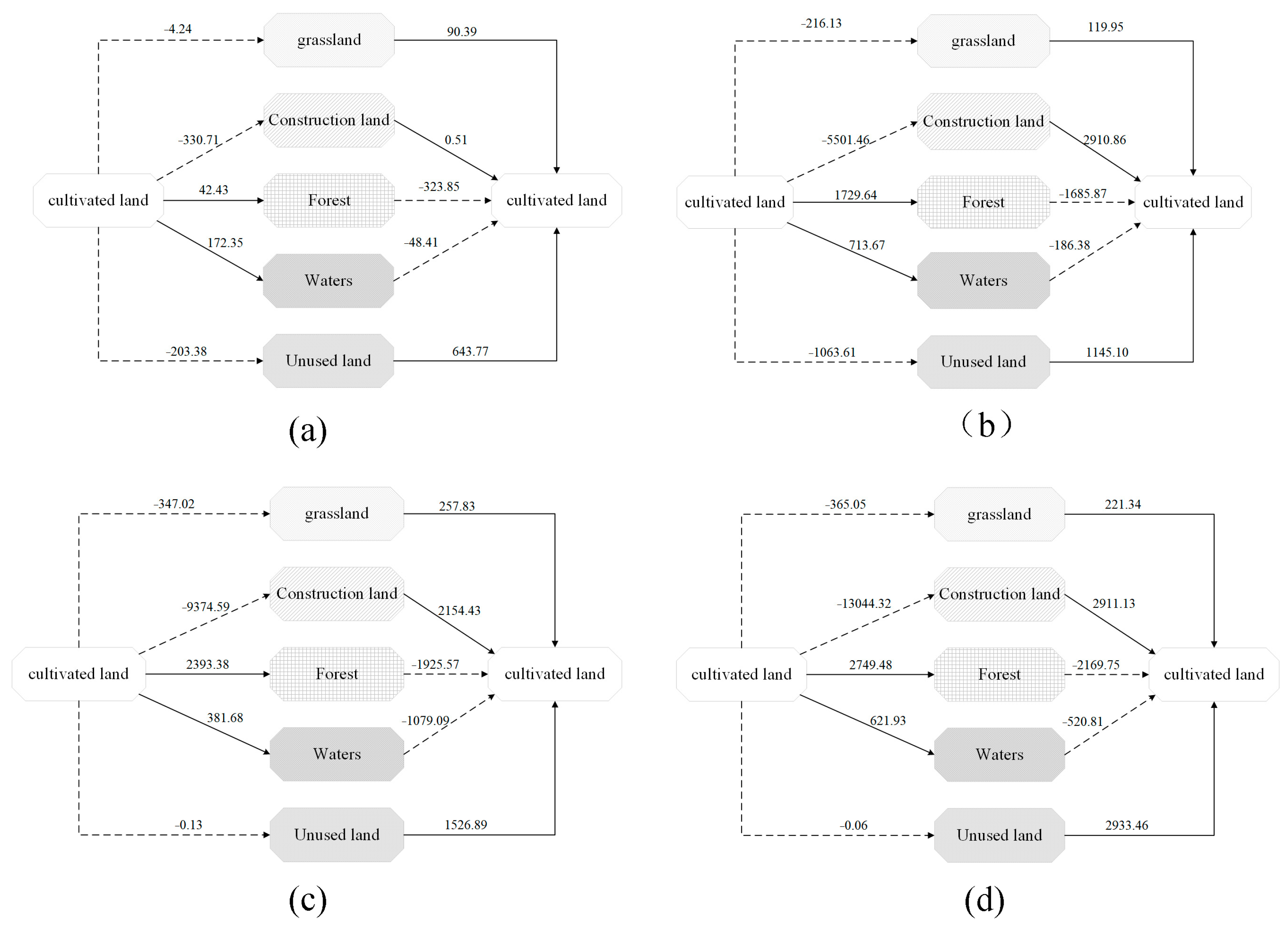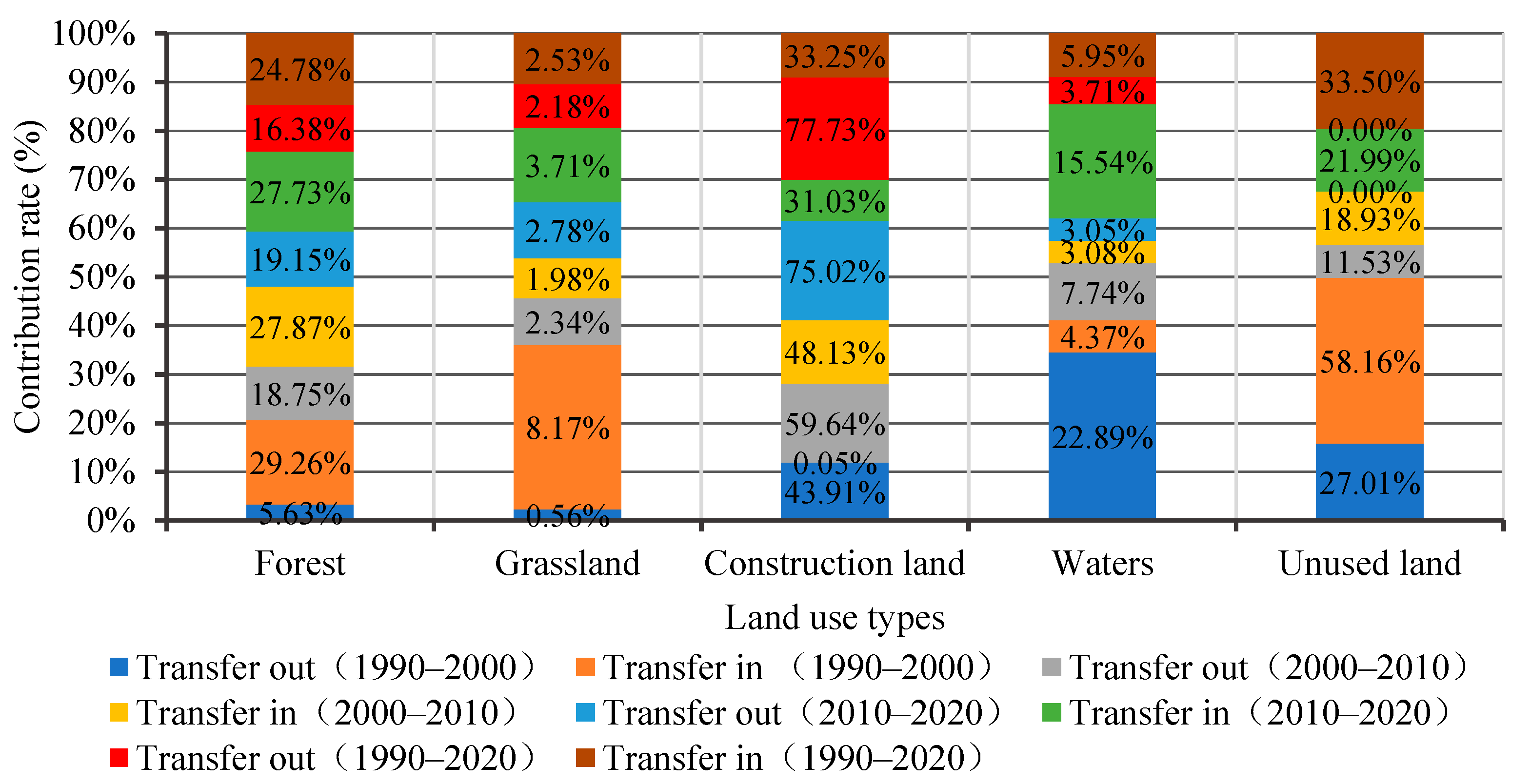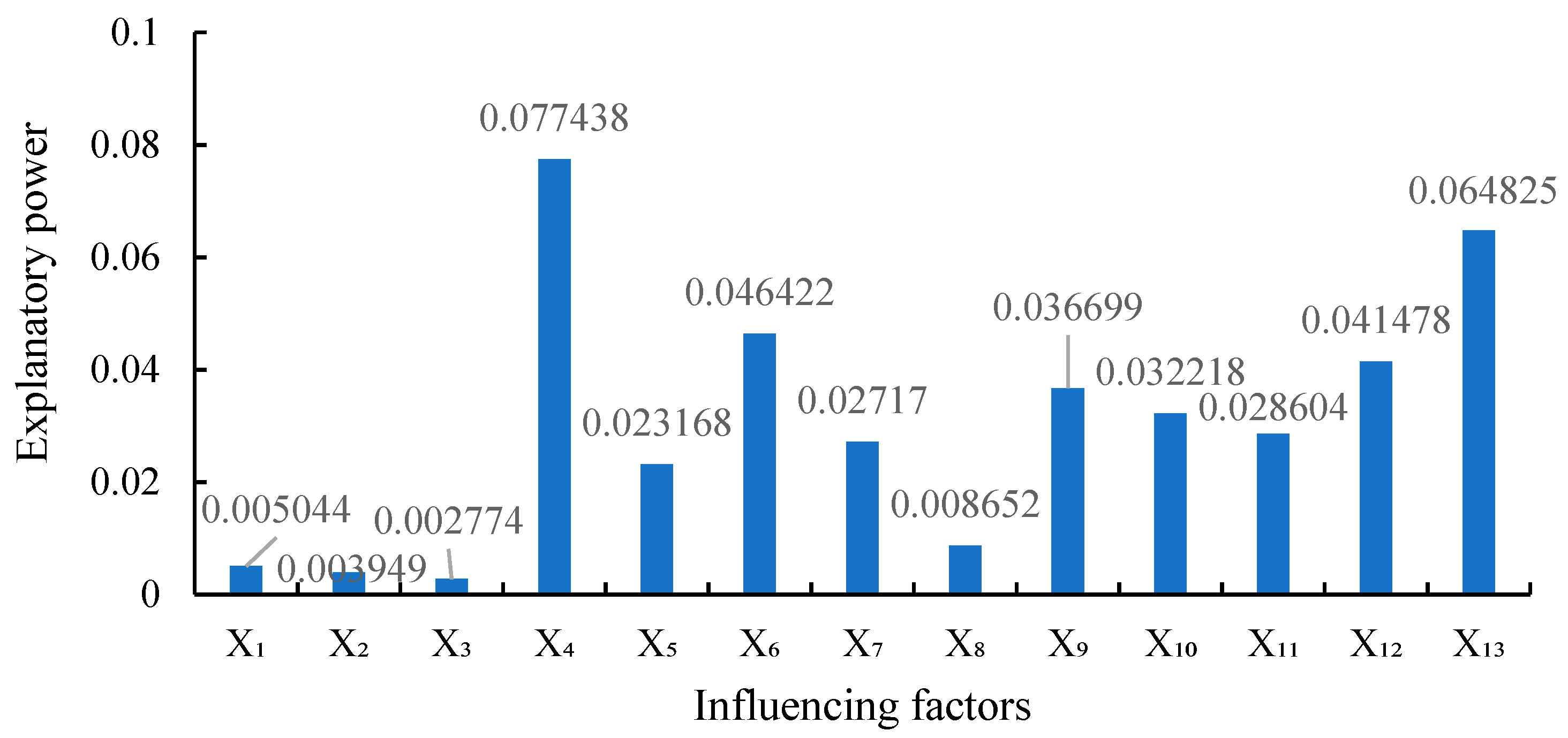Spatio-Temporal Differentiation and Driving Factors of Carbon Storage in Cultivated Land-Use Transition
Abstract
:1. Introduction
2. Materials and Methods
2.1. Study Area
2.2. Data Sources
2.3. Research Methods
2.3.1. Invest Model
2.3.2. Geographic Detector Model
3. Results
3.1. Structure Change Characteristics of Cultivated Land-Use Transition
3.2. Temporal Variation Characteristics of Carbon Storage in Response to Cultivated Land-Use Transition
3.3. Spatial Characteristics of Carbon Storage of Cultivated Land-Use Transition
3.4. Driving Factors of Carbon Storage Response to Cultivated Land-Use Transition
4. Discussion
5. Conclusions
- (1)
- Strengthen the protection of cultivated land and the economical and intensive use of construction land to reduce the impact of construction land expansion on carbon storage. Simultaneously, idle and abandoned construction land should be actively utilized or reclaimed into forest or cultivated land to guide the moderately intensive development of cultivated land;
- (2)
- Forest land has a high carbon density, which could effectively increase the level of carbon sink. Therefore, the stability of forest land ecosystems should be maintained as far as possible, and the scale of forest land should be continuously increased. Under the premise of ensuring China’s food security, the policy of returning farmland to forest should be vigorously implemented.
- (3)
- Actively implement ecological protection and restoration projects, and continuously explore the systematic restoration of ecological corridors, river systems, and important ecological functional areas, and explore restoration and treatment measures.
- (4)
- Strengthen the measurement and monitoring of carbon emissions from land-use type conversion, so as to develop land-use patterns conducive to carbon sinks.
Supplementary Materials
Author Contributions
Funding
Institutional Review Board Statement
Informed Consent Statement
Data Availability Statement
Acknowledgments
Conflicts of Interest
References
- Elahi, E.; Khalid, Z.; Tauni, M.Z.; Zhang, H.; Lirong, X. Extreme weather events risk to crop-production and the adaptation of innovative management strategies to mitigate the risk: A retrospective survey of rural Punjab, Pakistan. Technovation 2022, 117, 102255. [Google Scholar] [CrossRef]
- Abbas, A.; Waseem, M.; Ahmad, R.; Khan, K.A.; Zhao, C.; Zhu, J. Sensitivity analysis of greenhouse gas emissions at farm level: Case study of grain and cash crops. Environ. Sci. Pollut. Res. 2022, 29, 82559–82573. [Google Scholar] [CrossRef]
- Abbas, A.; Zhao, C.; Waseem, M.; Khan, K.A.; Ahmad, R. Analysis of Energy Input–Output of Farms and Assessment of Greenhouse Gas Emissions: A Case Study of Cotton Growers. Front. Environ. Sci. 2022, 9, 725. [Google Scholar] [CrossRef]
- Elahi, E.; Khalid, Z.; Zhang, Z. Understanding farmers’ intention and willingness to install renewable energy technology: A solution to reduce the environmental emissions of agriculture. Appl. Energy 2022, 309, 118459. [Google Scholar] [CrossRef]
- Liu, M.; Dong, X.; Wang, X.-C.; Zhao, B.; Fan, W.; Wei, H.; Zhang, P.; Liu, R. Evaluating the future terrestrial ecosystem contributions to carbon neutrality in Qinghai-Tibet Plateau. J. Clean. Prod. 2022, 374, 133914. [Google Scholar] [CrossRef]
- Xiang, S.; Wang, Y.; Deng, H.; Yang, C.; Wang, Z.; Gao, M. Response and multi-scenario prediction of carbon storage to land use/cover change in the main urban area of Chongqing, China. Ecol. Indic. 2022, 142, 129205. [Google Scholar] [CrossRef]
- Dinakaran, J.; Chandra, A.; Chamoli, K.; Deka, J.; Rao, K. Soil organic carbon stabilization changes with an altitude gradient of land cover types in central Himalaya, India. Catena 2018, 170, 374–385. [Google Scholar] [CrossRef]
- Zhang, M.; Al Kafy, A.; Xiao, P.; Han, S.; Zou, S.; Saha, M.; Zhang, C.; Tan, S. Impact of urban expansion on land surface temperature and carbon emissions using machine learning algorithms in Wuhan, China. Urban Clim. 2023, 47, 101347. [Google Scholar] [CrossRef]
- Chen, H.; Qi, S.; Zhang, J. Towards carbon neutrality with Chinese characteristics: From an integrated perspective of economic growth-equity-environment. Appl. Energy 2022, 324, 119719. [Google Scholar] [CrossRef]
- Ansari, M.A.; Choudhury, B.U.; Mandal, S.; Jat, S.L.; Meitei, C.B. Converting primary forests to cultivated lands: Long-term effects on the vertical distribution of soil carbon and biological activity in the foothills of Eastern Himalaya. J. Environ. Manag. 2021, 301, 113886. [Google Scholar] [CrossRef]
- Benbi, D.K.; Brar, K.; Toor, A.S.; Singh, P. Total and labile pools of soil organic carbon in cultivated and undisturbed soils in northern India. Geoderma 2015, 237–238, 149–158. [Google Scholar] [CrossRef]
- Das, S.; Bhattacharyya, R.; Das Saha, N.; Ghosh, A.; Khan, S.; Ahmed, N.; Dey, A.; Bhatia, A.; Pramanik, P.; Kumar, S.N.; et al. Soil aggregate-associated carbon and organic carbon pools as affected by conversion of forest lands to agriculture in an acid soil of India. Soil Tillage Res. 2022, 223, 105443. [Google Scholar] [CrossRef]
- Wu, J.; Bai, Z. Spatial and temporal changes of the ecological footprint of China’s resource-based cities in the process of urbanization. Resour. Policy 2022, 75, 102491. [Google Scholar] [CrossRef]
- Zhang, H.; Li, S. Carbon emissions’ spatial-temporal heterogeneity and identification from rural energy consumption in China. J. Environ. Manag. 2021, 304, 114286. [Google Scholar] [CrossRef]
- Morkner, P.; Bauer, J.; Creason, C.; Sabbatino, M.; Wingo, P.; Greenburg, R.; Walker, S.; Yeates, D.; Rose, K. Distilling data to drive carbon storage insights. Comput. Geosci. 2021, 158, 104945. [Google Scholar] [CrossRef]
- Zheng, J.; Duan, H.; Yuan, Y. Perspective for China’s carbon capture and storage under the Paris agreement climate pledges. Int. J. Greenh. Gas Control 2022, 119, 103738. [Google Scholar] [CrossRef]
- Ferreiro-Domínguez, N.; Palma, J.; Paulo, J.; Rigueiro-Rodríguez, A.; Mosquera-Losada, M. Assessment of soil carbon storage in three land use types of a semi-arid ecosystem in South Portugal. Catena 2022, 213, 106196. [Google Scholar] [CrossRef]
- Li, W.; Jia, S.; He, W.; Raza, S.; Zamanian, K.; Zhao, X. Analysis of the consequences of land-use changes and soil types on organic carbon storage in the Tarim River Basin from 2000 to 2020. Agric. Ecosyst. Environ. 2021, 327, 107824. [Google Scholar] [CrossRef]
- Dargains, A.; Cabral, P. A GIS-based methodology for sustainable farming planning: Assessment of land use/cover changes and carbon dynamics at farm level. Land Use Policy 2021, 111, 105788. [Google Scholar] [CrossRef]
- Tang, L.; Ke, X.; Zhou, Q.; Wang, L.; Koomen, E. Projecting future impacts of cropland reclamation policies on carbon storage. Ecol. Indic. 2020, 119, 106835. [Google Scholar] [CrossRef]
- Zhou, J.; Zhao, Y.; Huang, P.; Zhao, X.; Feng, W.; Li, Q.; Xue, D.; Dou, J.; Shi, W.; Wei, W.; et al. Impacts of ecological restoration projects on the ecosystem carbon storage of inland river basin in arid area, China. Ecol. Indic. 2020, 118, 106803. [Google Scholar] [CrossRef]
- Doe, B.; Amoako, C.; Adamtey, R. Spatial expansion and patterns of land use/land cover changes around Accra, Ghana—Emerging insights from Awutu Senya East Municipal Area. Land Use Policy 2021, 112, 105796. [Google Scholar] [CrossRef]
- Wang, B.; Tian, J.; Wang, S. Process and mechanism of transition in regional land use function guided by policy: A case study from Northeast China. Ecol. Indic. 2022, 144, 109527. [Google Scholar] [CrossRef]
- Wang, H.; Lu, S.; Lu, B.; Nie, X. Overt and covert: The relationship between the transfer of land development rights and carbon emissions. Land Use Policy 2021, 108, 105665. [Google Scholar] [CrossRef]
- Xu, Q.; Yang, R.; Dong, Y.-X.; Liu, Y.-X.; Qiu, L.-R. The influence of rapid urbanization and land use changes on terrestrial carbon sources/sinks in Guangzhou, China. Ecol. Indic. 2016, 70, 304–316. [Google Scholar] [CrossRef]
- Liu, J.; Guo, Q. A spatial panel statistical analysis on cultivated land conversion and chinese economic growth. Ecol. Indic. 2015, 51, 20–24. [Google Scholar] [CrossRef]
- Li, D.; Yang, Y.; Du, G.; Huang, S. Understanding the contradiction between rural poverty and rich cultivated land resources: A case study of Heilongjiang Province in Northeast China. Land Use Policy 2021, 108, 105673. [Google Scholar] [CrossRef]
- Shen, F.; Yang, L.; Zhang, L.; Guo, M.; Huang, H.; Zhou, C. Quantifying the direct effects of long-term dynamic land use intensity on vegetation change and its interacted effects with economic development and climate change in jiangsu, China. J. Environ. Manag. 2023, 325, 116562. [Google Scholar] [CrossRef]
- Xia, F.; Yang, Y.; Zhang, S.; Li, D.; Sun, W.; Xie, Y. Influencing factors of the supply-demand relationships of carbon sequestration and grain provision in China: Does land use matter the most? Sci. Total Environ. 2022, 832, 154979. [Google Scholar] [CrossRef] [PubMed]
- Li, B.; Yang, Z.; Cai, Y.; Xie, Y.; Guo, H.; Wang, Y.; Zhang, P.; Li, B.; Jia, Q.; Huang, Y.; et al. Prediction and valuation of ecosystem service based on land use/land cover change: A case study of the Pearl River Delta. Ecol. Eng. 2022, 179, 106612. [Google Scholar] [CrossRef]
- Kankam, S.; Osman, A.; Inkoom, J.N.; Fürst, C. Implications of Spatio-Temporal Land Use/Cover Changes for Ecosystem Services Supply in the Coastal Landscapes of Southwestern Ghana, West Africa. Land 2022, 11, 1408. [Google Scholar] [CrossRef]
- Chen, S.; Arrouays, D.; Angers, D.A.; Chenu, C.; Barré, P.; Martin, M.P.; Saby, N.P.; Walter, C. National estimation of soil organic carbon storage potential for arable soils: A data-driven approach coupled with carbon-landscape zones. Sci. Total Environ. 2019, 666, 355–367. [Google Scholar] [CrossRef] [PubMed]
- Chen, L.-C.; Guan, X.; Li, H.-M.; Wang, Q.-K.; Zhang, W.-D.; Yang, Q.-P.; Wang, S.-L. Spatiotemporal patterns of carbon storage in forest ecosystems in Hunan Province, China. For. Ecol. Manag. 2019, 432, 656–666. [Google Scholar] [CrossRef]
- Wang, S.; Xu, L.; Zhuang, Q.; He, N. Investigating the spatio-temporal variability of soil organic carbon stocks in different ecosystems of China. Sci. Total Environ. 2020, 758, 143644. [Google Scholar] [CrossRef]
- Pechanec, V.; Purkyt, J.; Benc, A.; Nwaogu, C.; Štěrbová, L.; Cudlín, P. Modelling of the carbon sequestration and its prediction under climate change. Ecol. Inform. 2018, 47, 50–54. [Google Scholar] [CrossRef]
- Zhao, H.; Qin, J.; Gao, T.; Zhang, M.; Sun, H.; Zhu, S.; Xu, C.; Ning, T. Immediate and long-term effects of tillage practices with crop residue on soil water and organic carbon storage changes under a wheat-maize cropping system. Soil Tillage Res. 2021, 218, 105309. [Google Scholar] [CrossRef]
- Chen, W.; Lei, Y.; Wu, S.; Li, L. Opportunities for low-carbon socioeconomic transition during the revitalization of Northeast China: Insights from Heilongjiang province. Sci. Total Environ. 2019, 683, 380–388. [Google Scholar] [CrossRef]
- Zhang, Y.; Zhao, F.; Zhang, J.; Wang, Z. Fluctuation in the transformation of economic development and the coupling mechanism with the environmental quality of resource-based cities—A case study of Northeast China. Resour. Policy 2021, 72, 102128. [Google Scholar] [CrossRef]
- Wang, Y.; Deng, L.; Wu, G.; Wang, K.; Shangguan, Z. Estimates of carbon storage in grassland ecosystems on the Loess Plateau. Catena 2018, 164, 23–31. [Google Scholar] [CrossRef]
- Zhang, P.-P.; Li, Y.-H.; Yin, H.-R.; Chen, Q.-T.; Dong, Q.-D.; Zhu, L.-Q. Spatio-temporal variation and dynamic simulation of ecosystem carbon storage in the north-south transitional zone of China. J. Nat. Resour. 2022, 37, 1183–1197. [Google Scholar] [CrossRef]
- Babbar, D.; Areendran, G.; Sahana, M.; Sarma, K.; Raj, K.; Sivadas, A. Assessment and prediction of carbon sequestration using Markov chain and InVEST model in Sariska Tiger Reserve, India. J. Clean. Prod. 2020, 278, 123333. [Google Scholar] [CrossRef]
- Zhuo, Z.; Chen, Q.; Zhang, X.; Chen, S.; Gou, Y.; Sun, Z.; Huang, Y.; Shi, Z. Soil organic carbon storage, distribution, and influencing factors at different depths in the dryland farming regions of Northeast and North China. Catena 2022, 210, 105934. [Google Scholar] [CrossRef]
- Wang, S.; Zhou, C.; Liu, J.; Tian, H.; Li, K.; Yang, X. Carbon storage in northeast China as estimated from vegetation and soil inventories. Environ. Pollut. 2001, 116, S157–S165. [Google Scholar] [CrossRef] [PubMed]
- Li, K.; Wang, S.; Cao, M. Vegetation and soil carbon storage in China. Sci. China Ser. D Earth Sci. 2004, 47, 49–57. [Google Scholar] [CrossRef]
- Alam, S.; Starr, M.; Clark, B. Tree biomass and soil organic carbon densities across the Sudanese woodland savannah: A regional carbon sequestration study. J. Arid. Environ. 2013, 89, 67–76. [Google Scholar] [CrossRef]
- Chen, G.; Yang, Y.; Xie, J.; Du, Z.; Zhang, J. The allocation of underground carbon in China’s forests. Acta Ecol. Sin. 2007, 27, 5148–5157. [Google Scholar] [CrossRef]
- Zhang, H.; Song, T.; Wang, K.; Yang, H.; Yue, Y.; Zeng, Z.; Peng, W.; Zeng, F. Influences of stand characteristics and environmental factors on forest biomass and root–shoot allocation in southwest China. Ecol. Eng. 2016, 91, 7–15. [Google Scholar] [CrossRef]
- Zhang, M.; Kafy, A.-A.; Ren, B.; Zhang, Y.; Tan, S.; Li, J. Application of the Optimal Parameter Geographic Detector Model in the Identification of Influencing Factors of Ecological Quality in Guangzhou, China. Land 2022, 11, 1303. [Google Scholar] [CrossRef]
- Zhu, X.-J.; Qu, F.-Y.; Fan, R.-X.; Chen, Z.; Wang, Q.-F.; Yu, G.-R. Effects of ecosystem types on the spatial variations in annual gross primary productivity over terrestrial ecosystems of China. Sci. Total Environ. 2022, 833, 155242. [Google Scholar] [CrossRef]
- Lyu, H.; Watanabe, T.; Kilasara, M.; Hartono, A.; Funakawa, S. Soil organic carbon pools controlled by climate and geochemistry in tropical volcanic regions. Sci. Total Environ. 2020, 761, 143277. [Google Scholar] [CrossRef]
- Jian, J.; Bahn, M.; Wang, C.; Bailey, V.L.; Bond-Lamberty, B. Prediction of annual soil respiration from its flux at mean annual temperature. Agric. For. Meteorol. 2020, 287, 107961. [Google Scholar] [CrossRef]
- Li, K.; Cao, J.; Adamowski, J.F.; Biswas, A.; Zhou, J.; Liu, Y.; Zhang, Y.; Liu, C.; Dong, X.; Qin, Y. Assessing the effects of ecological engineering on spatiotemporal dynamics of carbon storage from 2000 to 2016 in the Loess Plateau area using the InVEST model: A case study in Huining County, China. Environ. Dev. 2021, 39, 100641. [Google Scholar] [CrossRef]
- Chang, X.; Xing, Y.; Wang, J.; Yang, H.; Gong, W. Effects of land use and cover change (LUCC) on terrestrial carbon stocks in China between 2000 and 2018. Resour. Conserv. Recycl. 2022, 182, 106333. [Google Scholar] [CrossRef]
- Zong, S.; Hu, Y.; Zhang, Y.; Wang, W. Identification of land use conflicts in China’s coastal zones: From the perspective of ecological security. Ocean Coast. Manag. 2021, 213, 105841. [Google Scholar] [CrossRef]
- Zhu, L.; Song, R.; Sun, S.; Li, Y.; Hu, K. Land use/land cover change and its impact on ecosystem carbon storage in coastal areas of China from 1980 to 2050. Ecol. Indic. 2022, 142, 109178. [Google Scholar] [CrossRef]
- Feng, Y.; Chen, S.; Tong, X.; Lei, Z.; Gao, C.; Wang, J. Modeling changes in China’s 2000–2030 carbon stock caused by land use change. J. Clean. Prod. 2019, 252, 119659. [Google Scholar] [CrossRef]
- Wang, C.; Zhen, L.; Dui, B.Z.; Sun, C.Z. Assessment of the impact of grain for green project on farmers’ livelihood in the Loess plateau. Chin. J. Eco-Agric. 2014, 22, 850–858. [Google Scholar] [CrossRef]







| Land-Use Type | ||||
|---|---|---|---|---|
| Cultivated land | 3.87 | 14.90 | 20.66 | 39.43 |
| Forest | 12.27 | 21.90 | 30.02 | 64.19 |
| Grassland | 2.93 | 10.58 | 22.03 | 35.54 |
| Construction land | 2.52 | 2.75 | 8.43 | 13.70 |
| Water | 8.90 | 14.64 | 28.30 | 51.84 |
| Unused land | 0.91 | 0.00 | 14.66 | 15.57 |
| Periods | Center of Gravity | Standard Deviation of X axis/km | Standard Deviation of Y axis/km | Oblateness/km | Shape Index | Spindle Angle/°C | Elliptical Area/km2 |
|---|---|---|---|---|---|---|---|
| 1990–2000 | 126°49′58″ E | 28.91 | 73.26 | 0.61 | 0.39 | 136.78 | 6650.35 |
| 45°38′46″ N | |||||||
| 2000–2010 | 126°56′29″ E | 28.06 | 52.38 | 0.46 | 0.54 | 157.06 | 4615.12 |
| 45°47′31″ N | |||||||
| 2010–2020 | 126°48′54″ E | 28.10 | 60.93 | 0.54 | 0.46 | 141.1 | 5376.10 |
| 45°54′13″ N |
| X1 | X2 | X3 | X4 | X5 | X6 | X7 | X8 | X9 | X10 | X11 | X12 | X13 | |
|---|---|---|---|---|---|---|---|---|---|---|---|---|---|
| X1 | 0.0050 | ||||||||||||
| X2 | 0.008 + | 0.0039 | |||||||||||
| X3 | 0.0074 + | 0.0064 + | 0.0028 | ||||||||||
| X4 | 0.0893 * | 0.0844 * | 0.0827 * | 0.0774 | |||||||||
| X5 | 0.0316 * | 0.0289 * | 0.0283 * | 0.0848 + | 0.0232 | ||||||||
| X6 | 0.0527 * | 0.0522 * | 0.0526 * | 0.111 + | 0.0734 * | 0.0464 | |||||||
| X7 | 0.0312 + | 0.0314 * | 0.031 * | 0.0991 + | 0.0506 + | 0.0617 + | 0.0272 | ||||||
| X8 | 0.0164 * | 0.0165 * | 0.0162 * | 0.0988 * | 0.0331 * | 0.0665 * | 0.0359 + | 0.0087 | |||||
| X9 | 0.0456 * | 0.0401 + | 0.0392 + | 0.0977 + | 0.065 * | 0.0713 + | 0.0565 + | 0.0523 * | 0.0367 | ||||
| X10 | 0.0438 * | 0.0364 + | 0.0348 + | 0.093 + | 0.063 * | 0.065 + | 0.0502 + | 0.0445 * | 0.0411 + | 0.0322 | |||
| X11 | 0.0394 * | 0.0339 * | 0.033 * | 0.0893 + | 0.0596 * | 0.086 * | 0.0507 + | 0.0431 * | 0.0666 * | 0.058 + | 0.0286 | ||
| X12 | 0.0498 * | 0.0477 * | 0.0459 * | 0.0883 + | 0.0569 + | 0.0901 * | 0.0698 * | 0.0584 * | 0.0813 * | 0.0739 + | 0.0632 + | 0.0415 | |
| X13 | 0.0815 * | 0.0743 * | 0.0764 * | 0.1164 + | 0.0808 + | 0.1163 * | 0.0803 + | 0.0781 * | 0.0961 + | 0.0892 + | 0.084 + | 0.0853 + | 0.0648 |
Disclaimer/Publisher’s Note: The statements, opinions and data contained in all publications are solely those of the individual author(s) and contributor(s) and not of MDPI and/or the editor(s). MDPI and/or the editor(s) disclaim responsibility for any injury to people or property resulting from any ideas, methods, instructions or products referred to in the content. |
© 2023 by the authors. Licensee MDPI, Basel, Switzerland. This article is an open access article distributed under the terms and conditions of the Creative Commons Attribution (CC BY) license (https://creativecommons.org/licenses/by/4.0/).
Share and Cite
Gai, Z.; Xu, Y.; Du, G. Spatio-Temporal Differentiation and Driving Factors of Carbon Storage in Cultivated Land-Use Transition. Sustainability 2023, 15, 3897. https://doi.org/10.3390/su15053897
Gai Z, Xu Y, Du G. Spatio-Temporal Differentiation and Driving Factors of Carbon Storage in Cultivated Land-Use Transition. Sustainability. 2023; 15(5):3897. https://doi.org/10.3390/su15053897
Chicago/Turabian StyleGai, Zhaoxue, Ying Xu, and Guoming Du. 2023. "Spatio-Temporal Differentiation and Driving Factors of Carbon Storage in Cultivated Land-Use Transition" Sustainability 15, no. 5: 3897. https://doi.org/10.3390/su15053897




